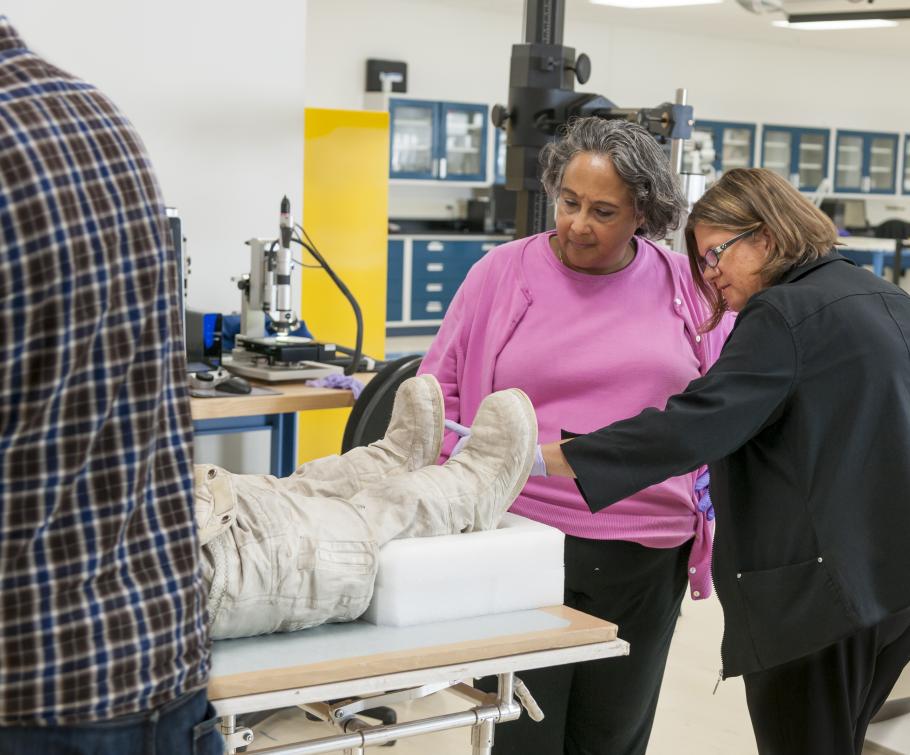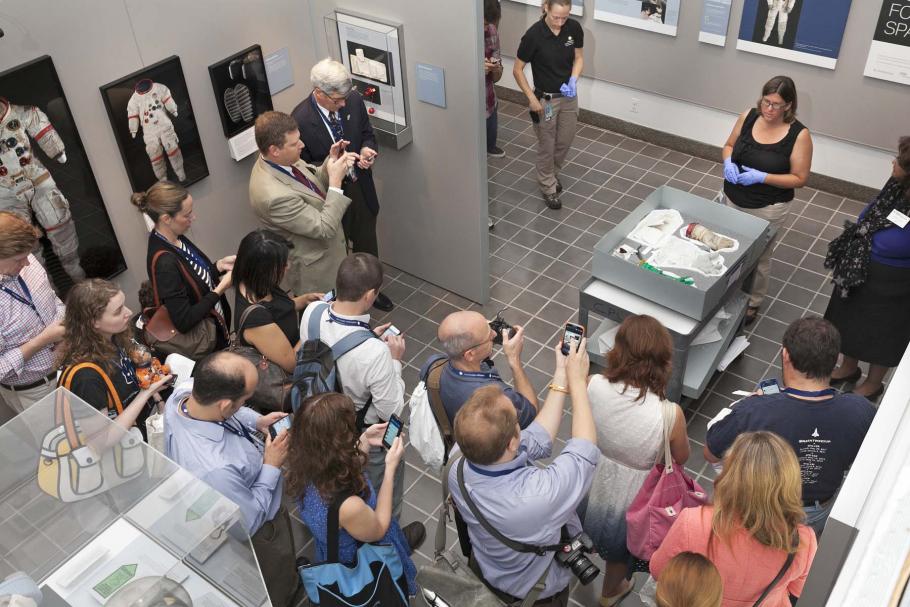The Smithsonian’s first-ever Kickstarter campaign to conserve, digitize, and display Neil Armstrong’s Apollo 11 spacesuit was fully backed in just five days! So what’s next? For Armstrong’s spacesuit, the conservation team is ready to launch. Here’s some of what we will begin working on in the upcoming months and a description of the conservation process that will take place throughout the project. Conservation 101: The primary goal of any conservation project is to stabilize the object for the future so it will last for generations to come. Conservators have specialized training in order to make important decisions about the care of museum objects. These decisions are not made alone—in a large museum such as the National Air and Space Museum, we often work with a team of people including scientists, curators, and outside experts in the materials, technology, and engineering of objects.
Lisa Young, conservator, and Cathleen Lewis, curator, examine the soles of Neil Armstrong's Apollo 11 boots.
The first step of any conservation project, large or small, is to undertake a careful examination of the object. The purpose of “looking” at the object in a detailed way serves many purposes. It will familiarize us with the object, the materials it is made of, and what condition the materials are in. We will want to find out if the materials are stable or whether they show signs of breaking down. Another step is to research historical documents. By working with the curator, in this case Cathleen Lewis, we will also need to understand the history of the object and what details found on the object could be a result of its history, use, or even changes made during its manufacturing. The object is the primary document, and even though we have information on spacesuits in general, each object is unique and tells a different story. During this initial examination, it is common to perform non-destructive testing, analysis, photography, and additional imaging of the object to gather and record as much information as possible. This portion of the project may take up to nine months and will allow us to develop a detailed condition map and collect data of the interior and exterior layers of the suit.
Conservator Lisa Young uses a Bruker hand-held XRF (X-ray Florescence) to perform non-destructive elemental analysis of metal alloys.
When this portion of the project is complete the conservation team will put together a plan to treat the object and present this to the curator. Conservators use their knowledge of chemistry and materials to decide how best to keep the object from deteriorating in the future. These decisions can be challenging, particularly when you have an object, like Armstrong’s spacesuit, composed of over 24 materials, some of which are not visible! Active treatment can involve surface cleaning, conducting repairs, or applying treatments that slow the rate of deterioration. Often, we spend time testing similar materials and perfecting our methods before attempting any treatment on the real object. It is not uncommon to consult industry experts to rely on their skills for help. For this project, it will include the people and companies who all contributed to making the Apollo spacesuits in the 1960s. A major part of any treatment plan involves determining the best environment in which to keep the object to slow down the aging of the materials. For the conservation work on Neil Armstrong’s spacesuit, the majority of the treatment timeline will be spent doing just this. Much of the intervention to stabilize this object for display will be controlling the display environment to ensure the long-term preservation of the spacesuit. Factors we will look at and test include temperature and relative humidity levels, light levels, ventilation, and minimizing physical stress to materials. Building a new state-of-the-art display case and testing the environment within the case will take almost a year to accomplish. Our goal is to replicate the ideal storage environment in a display case so we can make the suit available for every visitor. We need to make sure it is exactly right before we put the spacesuit in. The mannequin that we will develop and build to support the suit will also provide an ideal environment for displaying the suit. The suit is currently stored separately from its gloves and helmet, lying down, but our goal is to display it fully assembled with a new system to support the gloves and helmet in close proximity to the suit. Once the suit is fully upright, the 3D scanning of the suit can take place. This is the main reason why the digitization portion of the project will not happen for another two years; the suit will need to be fully outfitted and supported in a vertical position in order for us to scan it and develop our online content. In addition to all the work mentioned above, the conservation team will be providing updates, presenting professional papers, publishing a book, and participating in educational programs at our Museum and online. Our conservation team takes part in public outreach and educational projects to enhance the public’s understanding of what a museum conservator does and to introduce children and adults to a career in museums that they may not have been exposed to in all their years at school.
Conservator Lisa Young showed items from our collection not normally on view.
The Kickstarter project has allowed us to spread the word about what a museum conservator does behind the scenes and how we preserve objects so they can be displayed for the public to see. And now, there’s a second opportunity to help us conserve, digitize, and display another very important spacesuit. On Friday, July 24, we reached our goal of $500,000 to do the work needed on Armstrong’s suit—thank you! With plenty of days left on our Kickstarter project, we’ve added the stretch goal to conserve, digitize, and display Alan Shepard’s Mercury MR-3 spacesuit. This is the same spacesuit Shepard wore to become the first American in space in 1961. Like the Armstrong suit, Shepard’s spacesuit is slated to appear in the Museum’s Destination Moon exhibition in 2020, and will help show the progression of spacesuit technology during our early days of spacefaring. To meet this stretch goal, we’re hoping to raise an additional $200,000 and hit that $700,000 mark. As a conservator, being able to work on these spacesuits—artifacts that mean so much to so many people (see video below) and represent some of the most important events in American history—is the highlight of my career. Be sure to follow us on this journey and check back often for updates on our progress! Now we have to get to work…



